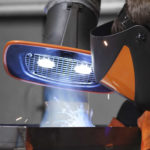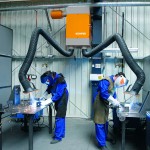Regulate extraction technology: for more ease in the battle against welding fumes
When considering extraction and filter technology, manufacturers do not only have to think about the protection of their employees against welding fumes or dust during welding, grinding or cutting. Efficient operation is important for welding workshops when it comes to the plants in addition to consideration on how hazardous substances are captured and discharged. Automatic suction performance regulation also saves energy.
One thing is certain regarding extraction and filtration systems for the metal sector: The protection against dangerous welding fumes or fine dust during grinding or cutting has top priority. Additional criteria are required for plants, however, which can guarantee effective occupational safety at several workstations at the same time in order to convince companies to make the investment in the end. The focus is for example on energy consumption.
Extract welding fumes with central systems
For multiple workstations, you have to assume that a mobile extraction device is no longer sufficient. Parallel work could no longer be guaranteed. Even several mobile units may cause problems, as they will be pushed around where required and are often simply an obstruction. Therefore, the choice falls frequently on central extraction plants, e.g. with wall mounted extraction arms. Depending on requirements, they can accommodate a range of air volume flows.
 Companies, however, should ask themselves one question: If ten workstations, each fitted with a point sensing element such as an easy to move extraction hood including extraction arm, are connected to one plant via a pipe system: Is it then really necessary to have the whole plant working at full power if only three persons are in the process of welding? The answer is clear: No! Especially since other processes such as aligning workpieces, tacking or grinding work mean that the actual arc welding time is often only 20 to 30 % of the working day.
Companies, however, should ask themselves one question: If ten workstations, each fitted with a point sensing element such as an easy to move extraction hood including extraction arm, are connected to one plant via a pipe system: Is it then really necessary to have the whole plant working at full power if only three persons are in the process of welding? The answer is clear: No! Especially since other processes such as aligning workpieces, tacking or grinding work mean that the actual arc welding time is often only 20 to 30 % of the working day.
Comfort plays a role in the purchase decision
The automatic suction power regulation ensures at all time that the exhaust performance required at any given moment is provided in order to deal with this problem. Using welding power detection at every workstation and automatic shut-off valves ensure that extraction only occurs in those places where someone is welding. The frequency converter regulates the fan speed and therefore the extraction performance as required.
The vacuum in the pipe remains constant, regardless if one or several employees are working in parallel. Welders do not experience any limitations in the capturing of welding fumes. Money spent on energy is saved since the plant reduces suction power automatically if there is less usage. This provides an increase in ease whilst saving energy.
New filter systems ensure reduced air resistance
The current state of the filter cartridge is also balanced with the control system. The air resistance of new filter cartridges is actually much lower than those that are currently in use. Without regulation, the suction power is therefore higher than necessary only to then subside unnecessarily fast because the filter cartridges have suffered due to the initially high suction performance. This situation is also balanced by the described suction power control. The suction power is just right from the beginning and the filter cartridges have a significantly longer service life.
All plant components are protected thanks to consistent suction performance in addition to energy savings and the increase in comfort. This has a positive effect on the service life of V-belts, bearings and filters. Besides, the plant runs more quietly and smoother. Likewise, current peaks on start-up of the plant are avoided which in turn has a positive effect on the electricity bill.





